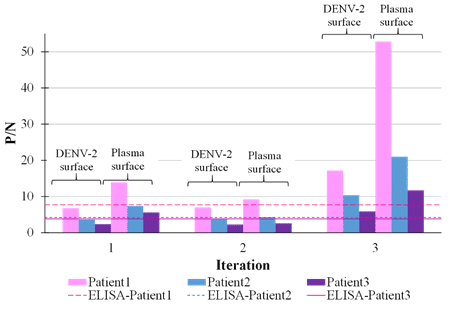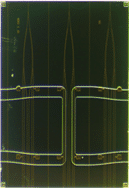
Long-Range Surface Plasmon Polariton (LRSPP) Waveguides as Dengue Biosensors
Dengue is a common mosquito-borne disease in tropical countries, with 390 million people being infected every year worldwide [1]. A novel compact dengue biosensor based on long-range surface plasmon polariton (LRSPP) waves is presented. The LRSPP based biosensor consists of thin gold metal waveguides embedded in CYTOP claddings (a fluoropolymer having a refractive index close to that of biologically compatible fluids) with the incorporation of fluidic channels. Present work demonstrates the ability of straight plasmonic waveguides to sense, in real-time and immunologically, dengue antibodies in patient blood plasma [2]. Two surface functionalization approaches are proposed and demonstrated: a dengue virus serotype 2 (DENV-2) functionalized surface to capture dengue-specific immunoglobulin M (IgM) antibody in blood plasma, and the reverse, a blood plasma functionalized surface to capture DENV-2. The positive-to-negative (P/N) ratio was applied to our experimental results. The results obtained via these two surface functionalization approaches are comparable to, or of greater quality, than those collected by standard laboratory diagnostic test, IgM Antibody Capture Enzyme Linked Immunosorbent Assay (MAC-ELISA), as shown in Figure 1. The plasma functionalized surface is found to be the simplest and most effective technique reported so far to minimize non-specific binding in complex fluid such as blood samples. In addition, the reuse of the biosensors is demonstrated by regenerating the sensing surface down to the virus (or antibody) level or down to the bare gold. Recently, we designed and fabricated a new dengue biosensor which is able to simultaneously detect the dengue virus and dengue-specific antibody in patient blood plasma (Figure 2, unpublished). Results using this new platform will also be presented.


References:
[1] S. Bhatt, P. W. Gething, O. J. Brady, J. P. Messina, A. W. Farlow, C. L. Moyes, et al., "The global distribution and burden of dengue," Nature, vol. 496, pp. 504-507, 2013.
[2] W. R. Wong, O. Krupin, S. D. Sekaran, F. R. Mahamd Adikan, and P. Berini, "Serological diagnosis of dengue infection in blood plasma using long-range surface plasmon waveguides," Analytical chemistry, vol. 86, pp. 1735-1743, 2014.
wongweiru88@yahoo.com
Powered by Eventact EMS